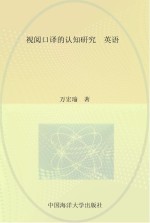

视阅口译的认知研究PDF电子书下载
- 电子书积分:11 积分如何计算积分?
- 作 者:万宏瑜著
- 出 版 社:青岛:中国海洋大学出版社
- 出版年份:2017
- ISBN:9787567013841
- 页数:270 页
Chapter 1 Introduction 1
1.1 The statement of the problem 3
1.2 The goal of the study 4
1.3 The scope of the study 5
1.4 Methodology and procedures 8
1.5 The outline of the study 10
Chapter 2 Literature Review 12
2.1 Previous studies 14
2.1.1 The Effort Model 14
2.1.2 Risks analysis 18
2.1.3 Advantages analysis 20
2.2 Criteria of ST 24
2.2.1 Quality assurance 24
2.2.2 The orality shift of the translated language 26
2.3 Characteristics of text for ST 27
2.3.1 Spoken vs.visual 28
2.3.2 Reading vs.listening 30
2.3.3 Linguistic features 31
2.3.4 Word order discrepancy 36
2.4 ST skills 38
2.5 Summary 40
Chapter 3 A Cognitive Study of ST Process 42
3.1 Reading comprehension in ST 42
3.1.1 Written language processing 44
3.1.2 Sentence comprehension 46
3.1.3 Parsing strategies 49
3.1.4 Reading efficiency 51
3.1.5 Memory of meaning 54
3.1.6 Evidence from eye-tracking study 57
3.2 Segmentation 61
3.2.1 Surface structure vs.deep structure 61
3.2.2 Units of meaning 65
3.2.3 Segmentation 68
3.3 Coordination 71
3.3.1 Divided attention 72
3.3.2 Anticipation 77
3.4 Linguistic and extra-linguistic anticipation 83
3.5 Reorganization&production 86
3.6 The enriched model of ST 88
3.6.1 Survey 1 89
3.6.2 Experiment 1 91
3.6.3 The enriched ST model 94
3.7 Summary 96
Chapter 4 Syntactic Linearity in E-C ST 99
4.1 Syntactic linearity 101
4.2 Feasibility of syntactic linearity in E-C ST 105
4.2.1 The Theme carrying Given Information 107
4.2.2 The Theme carrying New Information 109
4.2.3 The Theme carrying Zero Information 113
4.3 Summary 115
Chapter 5 The Experiment on Effectiveness of ST on CI 117
5.1 The research questions 117
5.2 Theoretical basis of the experiment 118
5.3 Research design 120
5.4 Subjects 121
5.5 Materials 123
5.6 Experiment procedures 125
5.7 Experiment results and analyses 126
5.7.1 Descriptive and inferential statistical analyses 128
5.7.2 Examples analysis 129
5.8 Summary 132
Chapter 6 Theoretical&Practical Implications 134
6.1 The present situation of interpreting training 134
6.2 Implications of ST in interpreting training 138
6.2.1 Reading efficiency and ST performance 138
6.2.2 Cloze test,anticipation and ST performance 141
6.2.3 Passive voice in ST 151
6.2.4 Explicitation and its implications on teaching 157
6.2.5 Significance of student peer feedback in ST training 174
6.3 ST training and brain plasticity 194
6.4 Summary 205
Chapter 7 Conclusion 208
7.1 Significance of the major findings 209
7.2 Theoretical implications of the study 212
7.3 Suggestions for further research 213
Bibliography 216
Appendices 245
Postscript 267
- 《红色旅游的社会效应研究》吴春焕著 2019
- 《汉语词汇知识与习得研究》邢红兵主编 2019
- 《生物质甘油共气化制氢基础研究》赵丽霞 2019
- 《东北民歌文化研究及艺术探析》(中国)杨清波 2019
- 《联吡啶基钌光敏染料的结构与性能的理论研究》李明霞 2019
- 《异质性条件下技术创新最优市场结构研究 以中国高技术产业为例》千慧雄 2019
- 《法语词汇认知联想记忆法》刘莲编著 2020
- 《《国语》和《战国策》词汇比较研究》陈长书著 2017
- 《中国制造业绿色供应链发展研究报告》中国电子信息产业发展研究院 2019
- 《行政保留研究》门中敬著 2019
- 《明清文化史散论》冯天瑜著 2018
- 《科技人生 第2辑》支德瑜著 2015
- 《明清贡院建筑》马丽萍,郭华瑜著 2013
- 《大明天子与大明帝国》赵世瑜著 2013
- 《下午茶 流年白话》陶文瑜著 2013
- 《博雅文丛 中国古代戏曲目录研究》王瑜瑜著 2013
- 《拉美国家扶贫政策研究 有条件现金转移支付计划》郑皓瑜著 2013
- 《说吧,从头说起》舒晋瑜著 2014
- 《秦始皇的创造艺术》杨端志,周晓瑜著 1993
- 《人生价值诗文粹》朱瑜著 2013
- 《大学计算机实验指导及习题解答》曹成志,宋长龙 2019
- 《中国当代乡土小说文库 本乡本土》(中国)刘玉堂 2019
- 《异质性条件下技术创新最优市场结构研究 以中国高技术产业为例》千慧雄 2019
- 《中国铁路人 第三届现实主义网络文学征文大赛一等奖》恒传录著 2019
- 《莼江曲谱 2 中国昆曲博物馆藏稀见昆剧手抄曲谱汇编之一》郭腊梅主编;孙伊婷副主编;孙文明,孙伊婷编委;中国昆曲博物馆编 2018
- 《海洋文明小史》倪谦谦责编;王存苗译;(法)雅克·阿塔利 2020
- 《中国制造业绿色供应链发展研究报告》中国电子信息产业发展研究院 2019
- 《中国陈设艺术史》赵囡囡著 2019
- 《《走近科学》精选丛书 中国UFO悬案调查》郭之文 2019
- 《大学生心理健康与人生发展》王琳责任编辑;(中国)肖宇 2019
